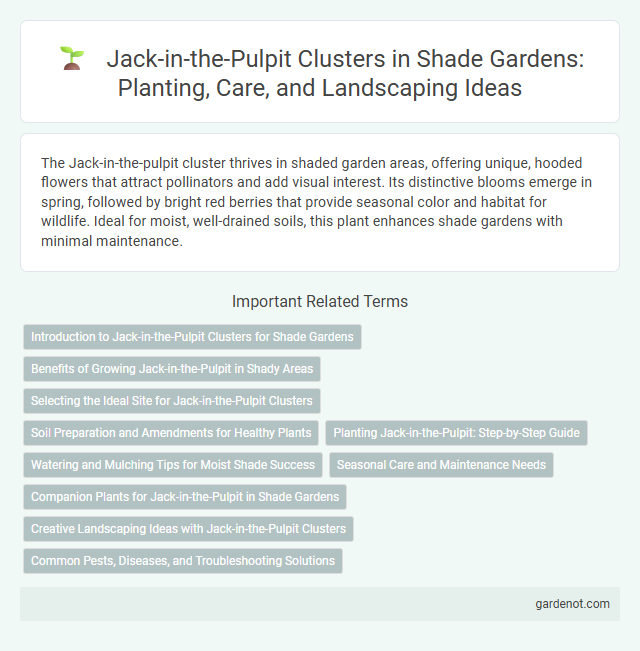The Jack-in-the-pulpit cluster thrives in shaded garden areas, offering unique, hooded flowers that attract pollinators and add visual interest. Its distinctive blooms emerge in spring, followed by bright red berries that provide seasonal color and habitat for wildlife. Ideal for moist, well-drained soils, this plant enhances shade gardens with minimal maintenance.
Introduction to Jack-in-the-Pulpit Clusters for Shade Gardens
Jack-in-the-Pulpit clusters thrive in shade gardens, offering unique, hooded flowers that provide visual interest during spring and early summer. These native woodland plants prefer acidic, moist, well-drained soil and dappled sunlight, making them ideal for under-canopy planting. Their distinctive spathe and spadix structure attracts pollinators while adding a striking architectural element to shaded landscapes.
Benefits of Growing Jack-in-the-Pulpit in Shady Areas
Jack-in-the-pulpit (Arisaema triphyllum) thrives in shady garden clusters by enhancing biodiversity and providing unique visual interest with its distinctive hooded flower. This plant benefits shaded areas by naturally deterring pests due to its toxic berries, reducing the need for chemical treatments. Its ability to adapt to moist, acidic soil conditions makes it a resilient and low-maintenance choice for understorey planting in woodland gardens.
Selecting the Ideal Site for Jack-in-the-Pulpit Clusters
Jack-in-the-pulpit clusters thrive best in moist, well-drained soil rich in organic matter, under partial to full shade conditions often found in deciduous forests. Choosing a site with consistent moisture and dappled sunlight mimics their natural woodland habitat, promoting healthy growth and vibrant coloration. Avoiding areas with excessive water runoff or direct afternoon sun enhances the longevity and bloom quality of Jack-in-the-pulpit clusters in shade gardens.
Soil Preparation and Amendments for Healthy Plants
Jack-in-the-pulpit thrives in moist, well-drained, acidic soil with a pH between 5.5 and 6.5, ideal for shade garden clusters. Incorporating organic matter such as leaf mold, compost, or well-rotted manure enriches soil structure and boosts nutrient availability, promoting vigorous growth. Regular mulching helps retain soil moisture and maintain consistent warmth, essential for healthy Jack-in-the-pulpit tubers.
Planting Jack-in-the-Pulpit: Step-by-Step Guide
Planting Jack-in-the-Pulpit in a shade garden requires selecting a moist, well-drained soil rich in organic matter, preferably under deciduous trees or dense shrubs. Begin by planting the corms 3 to 5 inches deep, spaced 6 to 12 inches apart to allow for natural clustering and growth. Maintain consistent moisture and mulch around the plants to preserve soil temperature and suppress weeds, encouraging robust development in shady conditions.
Watering and Mulching Tips for Moist Shade Success
Jack-in-the-pulpit thrives in consistently moist, well-drained soil, requiring regular watering to maintain dampness without waterlogging. Applying a 2-3 inch layer of organic mulch, such as shredded leaves or bark, helps conserve soil moisture and regulate temperature in shaded environments. Mulching also suppresses weeds and improves soil fertility, promoting healthy growth in shaded garden clusters.
Seasonal Care and Maintenance Needs
Jack-in-the-pulpit clusters require consistent moisture during their growing season, thriving in rich, well-drained soil with high organic content. Mulching around the base helps retain soil moisture and suppress weeds, while avoiding waterlogged conditions prevents root rot. After the foliage dies back in late fall, cutting stems to ground level supports healthy dormancy and prepares the plants for robust growth the following spring.
Companion Plants for Jack-in-the-Pulpit in Shade Gardens
Jack-in-the-pulpit thrives in moist, shaded environments and pairs well with ferns, hostas, and trilliums, which complement its unique structure while enhancing the garden's texture and color variety. Companion plants such as astilbes and Solomon's seal share similar soil and light requirements, promoting a harmonious and low-maintenance shade garden. Integrating these species creates a layered, naturalistic effect that supports biodiversity and maintains soil moisture.
Creative Landscaping Ideas with Jack-in-the-Pulpit Clusters
Jack-in-the-pulpit clusters create a striking focal point in shade gardens by adding vertical interest and unique texture with their hooded spathes and mottled leaves. Grouping these native perennials in layered arrangements alongside ferns and hostas enhances woodland aesthetics and supports local pollinators. Creative landscaping integrates natural stone pathways or mulch beds around clusters to highlight their dramatic, botanical architecture while promoting healthy soil moisture.
Common Pests, Diseases, and Troubleshooting Solutions
Jack-in-the-pulpit clusters in shade gardens are vulnerable to pests such as aphids and slugs, which can be controlled using insecticidal soap and organic slug bait. Common diseases include fungal leaf spots and root rot, often caused by poor drainage and excessive moisture, requiring improved soil aeration and fungicide treatments. Regular monitoring and maintaining proper growing conditions help prevent infestations and ensure healthy growth.
Jack-in-the-pulpit cluster Infographic

 gardenot.com
gardenot.com